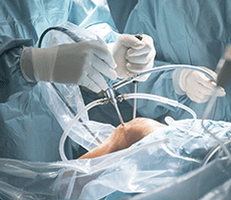How Surgeons Use Platelet-Rich Plasma (PRP) in Sports Injury Surgery in Karachi?

Platelet-Rich Plasma (PRP) therapy has become a popular and cutting-edge treatment option in sports injury surgery. In Karachi, where advancements in medical treatments continue to evolve, PRP is being used by orthopedic surgeons to accelerate healing and recovery for athletes and active individuals. PRP therapy involves using a concentrated sample of the patient’s own blood platelets to promote faster tissue repair and regeneration.
In this blog, we will explore how surgeons in Karachi are utilizing PRP in sports injury surgery, its benefits, and the specific injuries it can help treat.
1. What is Platelet-Rich Plasma (PRP) Therapy?
PRP therapy involves drawing a small amount of blood from the patient, which is then processed in a centrifuge to isolate the platelets. Platelets contain growth factors that play a crucial role in tissue healing and repair. Once the concentrated platelet-rich plasma is prepared, it is injected into the injury site to stimulate the body’s natural healing process.
How PRP Works:
- Growth Factors: The platelets in PRP release growth factors that promote the healing of damaged tissues, such as tendons, ligaments, and cartilage.
- Tissue Regeneration: PRP injections help stimulate cell proliferation and tissue regeneration, aiding in faster recovery.
- Reduced Inflammation: PRP can also help reduce inflammation and pain in the affected area.
2. PRP in Sports Injury Surgery
In Karachi, surgeons use PRP in conjunction with sports injury surgery to enhance healing outcomes. Whether it’s a torn ligament, tendon injury, or cartilage damage, PRP is often used as an adjunct therapy to support surgical repair.
Common Sports Injuries Treated with PRP:
- Tendon Injuries: Injuries such as Achilles tendonitis, tennis elbow, and rotator cuff tears can benefit from PRP therapy, which helps repair and regenerate damaged tendon tissue.
- Ligament Tears: For ligament injuries like ACL (anterior cruciate ligament) tears, PRP is used to accelerate healing after surgical repair.
- Cartilage Damage: PRP is effective in treating cartilage injuries by promoting cartilage regeneration and reducing pain, especially in knee and shoulder joints.
- Muscle Strains and Tears: Athletes with muscle strains or partial tears can receive PRP injections to speed up recovery and return to training sooner.
3. How PRP Enhances Surgical Recovery
PRP therapy is often combined with surgical procedures to enhance the body’s natural healing mechanisms. After surgery, healing can be slow, especially for soft tissue injuries like tendons or ligaments. PRP injections help boost the healing process, reducing recovery time and improving overall surgical outcomes.
Benefits of PRP Post-Surgery:
- Faster Recovery Time: By accelerating tissue regeneration, PRP helps patients heal faster than with surgery alone.
- Reduced Pain and Inflammation: PRP’s anti-inflammatory properties help reduce post-surgical pain and swelling.
- Improved Healing Outcomes: PRP promotes stronger and more resilient tissue repair, reducing the risk of re-injury.
4. PRP as a Non-Surgical Treatment Option
In addition to its use in surgical settings, PRP is also used as a non-surgical treatment option for certain sports injuries. In Karachi, orthopedic specialists often recommend PRP therapy for athletes who want to avoid surgery or need to treat chronic injuries.
Non-Surgical PRP Applications:
- Chronic Tendonitis: For chronic conditions like patellar tendonitis or tennis elbow, PRP offers a minimally invasive option to promote healing.
- Osteoarthritis: PRP can be used to treat early-stage osteoarthritis by helping regenerate cartilage and reduce joint pain.
- Partial Tears: Athletes with partial ligament or muscle tears can opt for PRP therapy to avoid surgery and speed up the healing process.
5. PRP in Karachi’s Sports Medicine Community
Karachi’s sports medicine community has embraced PRP as a powerful tool in injury management. Many sports injury specialists and orthopedic surgeons in the city are trained in the application of PRP therapy, ensuring that athletes receive the most advanced treatments available.
Why Athletes in Karachi Choose PRP:
- Minimally Invasive: PRP is a non-invasive or minimally invasive procedure, making it appealing for athletes looking for quick recovery with minimal downtime.
- Customizable Treatment: Since PRP is derived from the patient’s own blood, it’s a natural and personalized treatment option.
- Proven Results: PRP therapy has been shown to provide significant benefits for various sports injuries, helping athletes return to their sports faster and stronger.
6. The PRP Procedure: What to Expect
For those considering PRP therapy in Karachi, it’s essential to understand the procedure and what to expect.
The PRP Process:
- Blood Draw: A small amount of blood is drawn from the patient, usually from the arm.
- Centrifugation: The blood is placed in a centrifuge, which separates the platelets from other blood components.
- Injection: The concentrated PRP is injected into the injury site under ultrasound guidance to ensure precision.
Recovery After PRP:
- Minimal Downtime: PRP is a minimally invasive procedure, so recovery time is short. Most patients experience mild discomfort at the injection site but can resume normal activities within a day or two.
- Gradual Healing: Results from PRP are not immediate. Over the following weeks and months, the injury will gradually heal as the growth factors stimulate tissue repair.
7. Success Stories: PRP in Action
Numerous athletes in Karachi have experienced the benefits of PRP therapy, enabling them to recover faster from injuries and return to their sport. From professional cricketers to marathon runners, PRP has been instrumental in helping athletes regain their form and performance after injury.
Case Example: A young cricket player suffering from chronic elbow tendonitis received PRP therapy after conservative treatments failed. Within a few weeks, the pain subsided, and he returned to training. The PRP injections helped repair the tendon, allowing him to avoid surgery and continue playing without further complications.
Conclusion
PRP therapy has revolutionized sports injury treatment in Karachi, offering athletes a natural and effective way to enhance recovery. Whether used as part of surgical treatment or as a non-surgical option, PRP accelerates healing, reduces pain, and promotes long-term tissue repair. For athletes and active individuals looking to recover quickly and safely, PRP therapy is a valuable option in the growing field of sports medicine in Karachi.
With its proven results and minimal invasiveness, PRP therapy is helping athletes in Karachi get back in the game, stronger and more resilient than ever.

